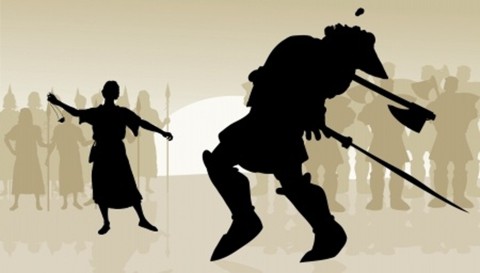There has been, and continues to be, discussion and debate about whether or not there existed giants in biblical times. Now, we know from First Samuel chapter 17 that Goliath was over 9 feet tall. If one considers a 9 foot tall man to be a giant (as I do), then clearly there existed giants in biblical times. However, the larger discussion concerning giants in the Bible centers around the phrase found in Genesis 6:2 “sons of God” and the meaning of the word “Nephilim” in Genesis 6:4:
“When man began to multiply on the face of the land and daughters were born to them, the sons of God saw that the daughters of man were attractive. And they took as their wives any they chose. Then the Lord said, “My Spirit shall not abide in man forever, for he is flesh: his days shall be 120 years.” The Nephilim were on the earth in those days, and also afterward, when the sons of God came in to the daughters of man and they bore children to them. These were the mighty men who were of old, the men of renown” (Genesis 6:1-4 ESV).
The discussion, or debate, over this passage centers around the definition of “daughters of man” and “sons of God”. Also, the definition of the word “Nephilim” plays into this issue and affects the interpretation one gleans from this passage. We will look at this issue and see if we can unpack some of the details.
“Daughters of men”
Most Bible commentators see the ‘daughters of men’ to be morally corrupt human women. These women were descended from the line of Cain instead of the godly line of Seth. Whoever the ‘sons of God’ were, these ‘daughters of men’ entered into sexual relationships with them.
“Sons of God”
Some believe that these ‘sons of God’ were the descendants of the godly son of Adam, Seth. These godly men succumbed to the temptations of the morally corrupted daughters of Adam (Cainites) and intermarried with them, thus corrupting their own godly lineage.
Others, believing that the name “Nephilim” has the Hebrew word ‘naphal’ (which means ‘to fall’) as its root, take these ‘sons of God’ to be fallen angels, not mere human men. Thus, these Bible scholars believe that human women mated with fallen angels and the result was a race of giants.
“Nephilim”
The group of Bible scholars believes that the Nephilim (often translated ‘giants’) were the result of the mating of the daughters of men and the sons of God. This union produced a race of giant beings. “The Greek translation of the Hebrew Scriptures rendered the name “Nephilim” as “giants,” and other versions followed this rendering, including the KJV” (Baker, Vol. 2, p. 1541). However, many now believe that the word should remain untranslated, and now appears as “…Nephilim, thus identifying them with the Anakim (Nm 13:33; Dt 2:21) and the Rephaim (Dt 2:20). The latter two were reputed to be large physically, hence the rendering “giants” (Baker, Vol. 2, p. 1541).
Differing Interpretations:
So, based on these differing definitions, we have two major competing interpretations of the Genesis 6:1-4 passage. The group that believes the ‘sons of God’ were fallen angels says that these fallen angels came to earth, desired human women, and mated with them with the resulting offspring being giants (Nephilim).
Another group, who believes the ‘sons of God’ to be the godly descendants of Seth, believe that these godly men married morally corrupt women with the resulting offspring following the corrupt morals of their mother’s lineage rather than the godliness of their father’s lineage. This group sees the Nephilim as an entirely separate race of humans that existed at the same time as the daughters of men and sons of God. Having no racial connection to either of the groups, these ‘giants’ were the kind of race that legends are written about (‘mighty men’ ‘men of renown’). Regardless of the interpretation, the overall moral climate of humanity was a downward spiral.
Objections to these interpretations:
One objection to the interpretation that the ‘sons of God’ were members of the godly lineage of Seth is the fact that nowhere in Scripture to this point are the descendants of Seth referred to as ‘sons of God’. Also, are we to assume that every descendant of Seth was a godly man; after all, they died in the flood too? And what about the ‘daughters of God’? Were they marrying ‘sons of men’? It seems like, if all this passage referred to was merely good and bad human males and females, these other issues would likely be addressed also.
One objection to the interpretation that the ‘sons of God’ were fallen angels is the statement of Jesus, in Matthew 22:30, that angels neither marry or are given in marriage. However, this simply tells us that the angels do not rightfully engage in marriage, we do not know what fallen angels are capable of doing. Also, whenever angels appear in the Bible, they are referred to as ‘men’ and the pronoun ‘he’ is used of them. In Genesis 19, the carnal men of Sodom wanted Lot to let them have the angels he protected so they apparently could have sex with them. Either these angels were physically capable of sexual relations or the men of Sodom simply thought they were, we just do not know. It is also possible, as Henry Morris points out in The Genesis Record, that fallen angels could have simply inhabited the bodies of human men in order to mate with human women (Morris, p. 169).
Conclusion
This is one of those issues that will likely be discussed and debated until Jesus comes back. There will be those who interpret it one way and others who favor a different interpretation. In cases like this, I like to step back and look at the big picture. Regardless, of the correct identification of the ‘sons of God’, or the ‘Nephilim’, we know that the overall gist of this portion of Scripture is that humanity was in the process of rejecting God, His Word, and His Lordship. Humankind would soon be destroyed, except for eight humans that God chose to save. In saving these eight, God not only assured the continuation of the human race, He also preserved the lineage of the Savior by Whom our sins would be paid.
There are so many lessons to be gleaned from this portion of the book of Genesis that it would take a separate article (or possibly many) to look at them all. However, what we see so clearly in this story is mankind’s rebellion against God, God’s judgment on that rebelliousness, and God’s salvation through obedience to His Word. These truths still hold today; if we remain in our rebellion against God, He will judge us; however, He sent His Son, Jesus Christ, to die on a cross so that, if we will repent of our sin and trust Him with our lives, He will forgive us and grant us eternal life. Just as God saved those eight in the times of the ‘sons of God’, He offers us that same salvation to us today. He is the same, “…yesterday, today, and forever” (Hebrews 13:8 ESV).
Read about Noah here: Noah’s Ark Bible Story
Resource – Scripture quotations are from The Holy Bible, English Standard Version® (ESV®), copyright © 2001 by Crossway, a publishing ministry of Good News Publishers. Used by permission. All rights reserved. Baker Encyclopedia of the Bible. Walter A. Elwell, ed. Baker Book House, 1988. Morris, Henry M. The Genesis Record. Baker Book House, 1976.









 Welcome to What Christians Want To Know! The mission of this site is to equip, encourage, and energize Christians. Look for regular updates including Bible Verses, Bible Stories, Christian Quotes, Christian Answers, and much more. Find out
Welcome to What Christians Want To Know! The mission of this site is to equip, encourage, and energize Christians. Look for regular updates including Bible Verses, Bible Stories, Christian Quotes, Christian Answers, and much more. Find out 









